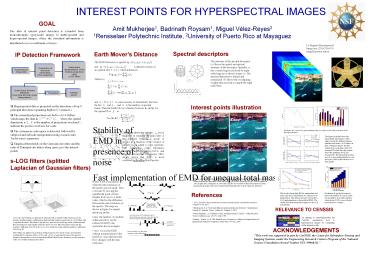INTEREST POINTS FOR HYPERSPECTRAL IMAGES - PowerPoint PPT Presentation
1 / 1
Title:
INTEREST POINTS FOR HYPERSPECTRAL IMAGES
Description:
Title: PowerPoint Presentation Last modified by: Amit Mukherjee Created Date: 1/1/1601 12:00:00 AM Document presentation format: Custom Other titles – PowerPoint PPT presentation
Number of Views:51
Avg rating:3.0/5.0
Title: INTEREST POINTS FOR HYPERSPECTRAL IMAGES
1
INTEREST POINTS FOR HYPERSPECTRAL IMAGES
GOAL
Amit Mukherjee1, Badrinath Roysam1, Miguel
Vélez-Reyes2 1Rensselaer Polytechnic Institute,
2University of Puerto Rico at Mayaguez
The idea of interest point detection is extended
from monochromatic (grayscale) images to
multi-spectral and hyper-spectral images, where
the structural information is distributed over
several bands or layers.
Spectral descriptors
Earth Movers Distance
The structure of the spectral descriptor. (a)
Shows the spatial and spectral structure of the
descriptor. Spatially, it has a central region
enclosed by eight radial regions as shown in part
(a). The spectral dimension is binned and
normalized. (b) Shows the overlapping weights
that are used to sample the eight radial bins.
The EMD between two spectra
and
is
defined in terms of an optimal flow
which minimizes, Subject to and
is some measure of dissimilarity
between the bin and , and
is the number of spectral bands. Then the Earth
Movers distance between and for the
optimal flow as
Interest points illustration
Stability of EMD in presence of noise
The figure above shows Key point matching using
Lowe 1 on each of the projections of the
hyperspectral image.
The figure shows the stability of the
EMD in retaining the rank-order of the distances
between a group of spectra, as a function of the
variance of additive noise added to each
spectrum. The comparison with Euclidean, Spectral
Angle Mapper (SAM) and Spectral information
Divergence (SID) clearly shows that EMD is more
consistent in handling noisy spectra.
The figure in the left shows the repeatability
performance of the interest points for different
distance measure used in the s-LOG filters on the
La Parguera dataset. The left column shows
matching of top 100 strongest IPs while the right
column shows the matching of top 200 strongest
IPs. The interpolation in the top row is done
independently in scale and space, while in the
bottom row is done jointly.
s-LOG filters (splitted Laplacian of Gaussian
filters)
Fast implementation of EMD for unequal total mass
The top row shows all those IPs that are matching
in scale and space of the top-300 interest points
using the proposed algorithm, while the bottom
row shows all the top-300 IPs of La Parguera at
2002 (right) and La Parguera at 2003 (left). The
IPs are overlaid on the RGB projection of the
hyperspectral image. The circle around each IP
indicates the scale at which it is detected.
- EMD is not a true metric when the sum total mass
of the spectra are not equal. This overcome by
moving the equilibrium point of mass transfer
from zero to a finite value, which is the
difference between the sum total mass of the
spectra. The steps are shown in figure for sample
spectra and . - Also, the number of variables in the mass flow
can be reduced to half by the operations shown in
figure. - Also, we use the EMD without normalization by
the total flow, since this the total flow changes
with the sum total mass.
References
The results of matching IPS for independent and
joint scale-space interpolation as compared to no
interpolation. The distance measure used in the
s-LOG implementation is the modified EMD. The
results show that interpolation improves the of
matched IPs.
Evaluation of spectral descriptors, Shows the
number of correct recalls for the number of
possible matches when the top-N IPs were
evaluated between the two images.
- Lowe, Distinctive Image Featuresfrom
Scale-Invariant Keypoints, International Journal
of Computer Vision, 2004. - Mikolajczyk et al. Scale and affine invariant
interest point detectors. International Journal
of Computer Vision, Volume 60, Number 1, 2004. - Harris-Stephens, A Combined Corner and Edge
Detector, In Proc. of the 4th Alvey Vision
Conference, pp. 147-151, Sept. 1988. - Rubner, Tomasi, et. al. The Earth Movers
Distance as a Metric for Image Retrieval.
International Journal of Computer Vision 40(2),
99121, 2000.
s-LOG are derived from a Laplacian of Gaussian
with a variable width. Shown in (a) are positive
and the negative coefficients in light and dark
shades respectively of a LOG filter with 1
standard deviation. This filter is split into two
parts based on the sign of the coefficients and
then normalized to unit weights. Panel (b) shows
s-LOG filter formed by using only the positive
coefficients of LOG in 2D. (c) s-LOG- formed by
using only the negative coefficients of LOG in
2D. These filters are applied on each layer of
the projection. Two pixel vectors are formed by
stacking the N responses of the s-LOG and s-LOG-
at each pixel location. The spectral distance
between these vectors (using the modified Earth
Movers distance) give the response of the s-LOG
filter at that pixel location.
ACKNOWLEDGEMENTS
This work was supported in part by CenSSIS, the
Center for Subsurface Sensing and Imaging
Systems, under the Engineering Research Centers
Program of the National Science Foundation (Award
Number EEC-9986821)."


















![The radiance received by a spaceborne or airborne instrument looking at nadir at an altitude of Z (km) is described by the RTE for plane parallel atmospheres as stated by Lenoble [1] is given by: PowerPoint PPT Presentation](https://s3.amazonaws.com/images.powershow.com/7507119.th0.jpg?_=20160102061)












